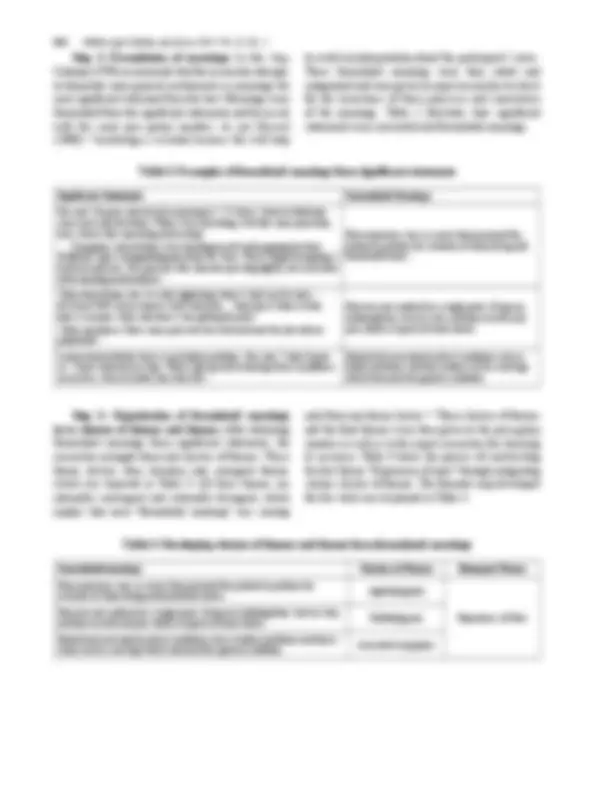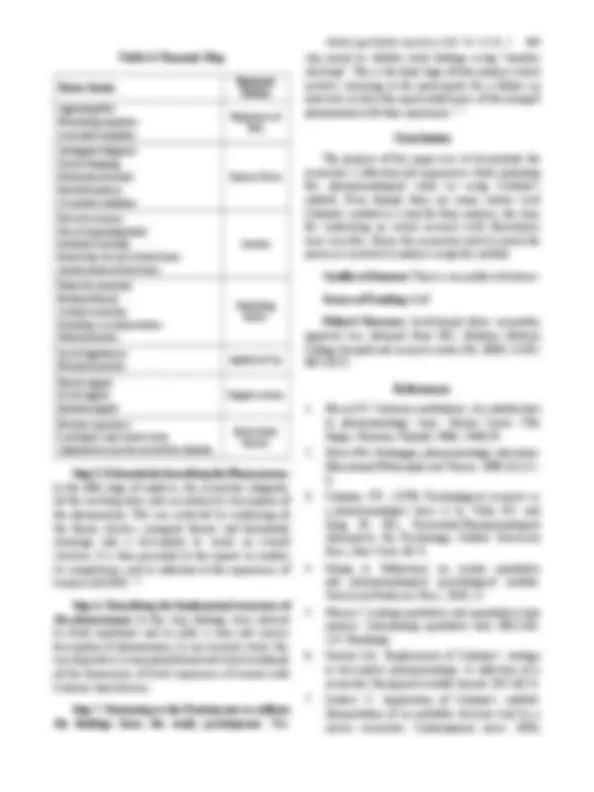





Study with the several resources on Docsity

Earn points by helping other students or get them with a premium plan


Prepare for your exams
Study with the several resources on Docsity

Earn points to download
Earn points by helping other students or get them with a premium plan
Community
Ask the community for help and clear up your study doubts
Discover the best universities in your country according to Docsity users
Free resources
Download our free guides on studying techniques, anxiety management strategies, and thesis advice from Docsity tutors
Aim: This paper aimed to explore the Colaizzi's method of descriptive data analysis to articulate the experiences of women living with Ischemic heart disease ( ...
Typology: Study notes
1 / 5

This page cannot be seen from the preview
Don't miss anything!




Praveena K.R.^1 , Sasikumar S. 2 (^1) Prof., PhD Scholar, Yenepoya (Deemed to be University), Mangalore, Karnataka, India, (^2) Professor, Yenepoya Nursing College, Yenepoya (Deemed to be University), Mangalore, Karnataka, India
Background: Phenomenology is a research method intended to explore the experiences of people as they live in different phases of their life. Aim: This paper aimed to explore the Colaizzi’s method of descriptive data analysis to articulate the experiences of women living with Ischemic heart disease (IHD).
Method: By using the actual research data, the technique of Colaizzi’s data analysis was used to extract, organize and analyze the data.
Results: Colaizzi’s strategy was effectively utilized in identifying significant statements from the transcribed verbatim and meanings were formulated. From these formulated meanings clusters of themes and themes were derived which eventually helped in the development of thematic map of experiences of women with Ischemic heart disease (IHD).
Conclusion: Colaizzi’s step of data analysis in descriptive phenomenology was effectively utilized in this research that facilitated in reflecting the experiences of IHD patients.
Keywords: Colaizzi’s data analysis, Phenomenology, Ischemic heart disease (IHD), Lived experience.
Phenomenology comes from the academic disciplines of Philosophy and psychology. Phenomenology can be divided into descriptive phenomenology created by Husserl^1 and interpretive- hermeneutic phenomenology created by Heidegger.^2 The design used in this study was descriptive phenomenological design.
There are four steps in descriptive phenomenology. They are bracketing, intuiting, analyzing and describing. Bracketing is the process of identifying and holding in abeyance the preconceived beliefs and opinions about phenomena under study. Intuiting occurs when researchers remain open to the meanings attributed
Corresponding Author: Prof. Praveena K.R. PhD Scholar, Yenepoya University, Mangalore, Karnataka, India e-mail: praveenadileep2001@gmail.com
to the phenomena by those who have experienced it. Phenomenological researchers then proceed to the analysis phase i.e. extracting significant statements, categorizing, and making sense of the essential meanings of the phenomenon. Finally, the descriptive phase occurs when researchers come to understand and define the phenomenon.1-
Step 1: Obtaining a general sense of each Transcript: In the study of lived experience of women with IHD, the researcher personally conducted the interviews, which helped to gain a holistic sense pertaining to the entire experiences of the participants. The audiotapes were read three to four times and attempted to comprehend the thought processes and the feelings of the participants. This was suggested by Colaizzi (1978)^3 that the investigator should read the audiotape many times in order to clearly understanding the content.
Step 2: Extracting significant statements: As per Colaizzi (1978), the researcher then extract significant phrases and statements from the transcript that together
form a whole meaning of the experience. I read and reread the transcript and analyzed each transcript to identify significant statements from the transcript. These statements were written separately for each participant and coded as transcript page number and line number.
This was given to a peer group member for checking to obtain clarity of thoughts and suggestions were incorporated. Table 1 illustrates some of the statements extracted from the interviews.
Each of the transcripts were read and re-read, in order to obtain a general sense about the whole content
Significant statements that relate to the phenomenon under study were extracted from transcripts
Formulated meanings were derived from significant statements
Organization of formulated meanings in to clusters of themes and themes
Integration of the findings into an exhaustive description
Description of the fundamental structure of the phenomenon
Validation of the findings from the study participants 7 Figure 1: The steps of Colaizzi’s Phenomenological Data Analysis
Table 1: Examples of Significant statements
Significant statements Participant TranscriptPage No LineNo
She said “It (pain) started early morning at 4 ‘O Clock, I went to bathroom came back and lied down. When I was stretching, I felt like some pain from here (Chest) like something obstructing”.
A 2 22
“Symptoms started as burning in the chest (nencherichil) and breathing difficulty…. That day it was severe distress and I was not getting breath. Initially pain was not so severe, … it started around 05.00 O’ clock in the evening;….. While moping, it had started suddenly, immediately I sat down, it was unbearable, was localized to chest only, not radiating, such a kind of distress, I tried to walk,… I water the plants, which made bit relief”.
C 19 3
“That day I was walking to neighbourhood house (brother’s house) for voting. Then all over I started getting pain, just like something scratching, like pricking with a throne”. F^31 “While coming back from a marriage function, ….“Symptoms started when I was bending myself and mopping the floor. Suddenly I got a strangulating pain from the chest. Then I stopped mopping. I had back pain too. The pain was like someone pressing tightly, not associated with vomiting and headache”.
I 49 3
“I did not have many difficulties afterwards (after the procedure, PTCA). Later I remember they are taking something from here….That was really a terrible experience to lie still with this pain”
J 52 3
Table 4: Thematic Map
Theme Cluster EmergentThemes Agonizing Pain Fluctuating symptoms Associated symptoms
Experience of Pain
Ambiguous diagnosis Doctor Shopping Medication overload Familial tendency Co morbid conditions
Disease Focus
Fear of recurrence Fear of impending death Irrational reasoning Shock from the loss of loved ones Anxiety about of loved ones
Anxiety
Financial constraints Burdened family Activity restriction Disturbance in daily routines Natural disasters
Stumbling blocks
Joy of togetherness Pleasant memories Sparkle of Joy Family support Social support Spiritual support
Support system
Previous experience Learning to cope various ways Adjustment as per the need of the situation
Break down barriers
Step 5. Exhaustively describing the Phenomenon: In the fifth stage of analysis, the researcher integrates all the resulting ideas into an exhaustive description of the phenomenon. This was achieved by combining all the theme clusters, emergent themes and formulated meanings into a description to create an overall structure. It is then presented to the experts to confirm its completeness and its reflection to the experiences of women with IHD. 6-
Step 6. Describing the fundamental structure of the phenomenon: In this step, findings were reduced to avoid repetitions and to make a clear and concise description of phenomenon. In my research study, this was depicted as a conceptual framework which contained all the dimensions of lived experience of women with Ischemic heart disease.
Step 7. Returning to the Participants to validate the findings from the study participants: This
step aimed to validate study findings using “member checking”. This is the final stage of data analysis which involves returning to the participants for a follow up interview, to elicit the representativeness of the emerged phenomenon with their experience.9-
The purpose of this paper was to disseminate the researcher’s reflection and experiences while analyzing this phenomenological study by using Colaizzi’s method. Even though there are many studies used Colaizzi’s method as a tool for their analysis, the steps for conducting an actual research with illustrations were very few. Hence the researcher tried to unveil the processes involved in analysis using this method.
Conflict of Interest: There is no conflict of interest.
Source of Funding: Self
Ethical Clearance : Institutional ethics committee approval was obtained from IEC, Malabar Medical College hospital and research centre (No. MMC & RC/ IEC/2017).